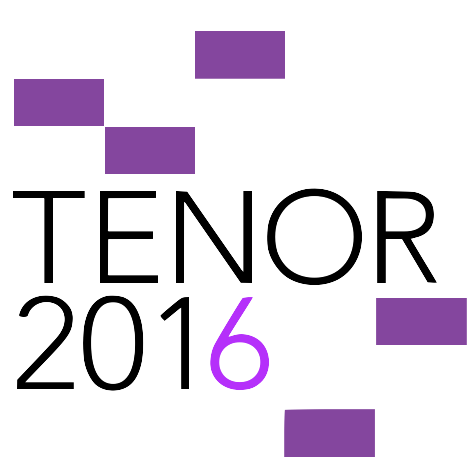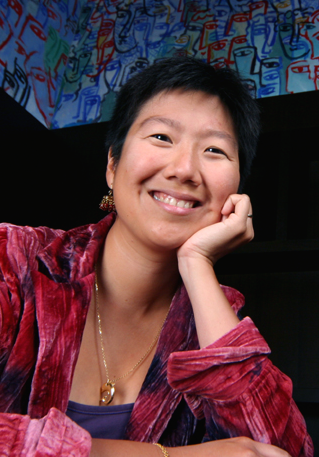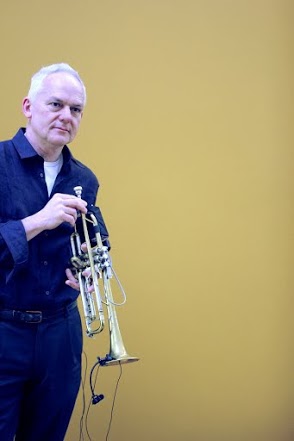
Programme
28 - 29 May 2016
Anglia Ruskin University, Cambridge, UK

09:00 Registration
09:20 Introduction
09:30
Real-Time Corpus-Based Concatenative Synthesis for Symbolic Notation
Bibtex
Abstract
![]()
09:50
Tension ribbons: Quantifying and visualising tonal tension
Bibtex
Abstract
![]()
10:10
Hybrid Real/Mimetic Sound Works
Bibtex
Abstract
![]()
10:30
Visualizing Music in its Entirety using Acoustic Features: Music Flowgram
Bibtex
Abstract
![]()
11:10
Swaralipi: A Framework for Transcribing and Rendering Indic Music Sheet
Bibtex
Abstract
![]()
11:30
Notating the Non-Notateable: Digital Notation of Txalaparta Practice
Bibtex
Abstract
![]()
11:50 Keynote
 Music as conceptualised in the mind and communicated in performance is more than that which is captured in conventional notation. It may be more than that which can be captured in notation, at least in human-readable form. Just how much of music can we make concrete through notation, or represent in graphs or mathematical models? And, of the multitude of possibilities, how do we select for the most relevant and crucial things to represent? Suppose that, in addition, beyond representation we wish to reveal why—why did the performer or composer choose this over that? why is this passage surprising?—thus veering towards questions of music cognition. How will the objective influence that which we devise to notate? We shall examine some of these issues through a series of experiments that aim to make tangible the ineffable nature of practicing and performing music. In particular, we consider the intentions that shape performances and the deeper music structures that guide them. The decisions and entities that musicians grapple with then provide impetus for the music representations.
Music as conceptualised in the mind and communicated in performance is more than that which is captured in conventional notation. It may be more than that which can be captured in notation, at least in human-readable form. Just how much of music can we make concrete through notation, or represent in graphs or mathematical models? And, of the multitude of possibilities, how do we select for the most relevant and crucial things to represent? Suppose that, in addition, beyond representation we wish to reveal why—why did the performer or composer choose this over that? why is this passage surprising?—thus veering towards questions of music cognition. How will the objective influence that which we devise to notate? We shall examine some of these issues through a series of experiments that aim to make tangible the ineffable nature of practicing and performing music. In particular, we consider the intentions that shape performances and the deeper music structures that guide them. The decisions and entities that musicians grapple with then provide impetus for the music representations.
12:30 Poster session and lunch
13:30
S-notation: A complete musical notation system for scratching and sample music derived from "Theory of Motions"
Bibtex
Abstract
![]()
14:15
Pitchcircle3D: A Case Study in Live Notation for Interactive Music Performance
Bibtex
Abstract
![]()
15:20
Performance Practice of Real-Time Notation
Bibtex
Abstract
![]()
15:40
Representing atypical music notation practices: An example with late 17th century music
Bibtex
Abstract
![]()
16:40
Is There a Data Model in Music Notation?
Bibtex
Abstract
![]()
17:00
The Ontology of Live Notations Through Assemblage Theory
Bibtex
Abstract
![]()
17:20
[Study no. 50][Notational Becoming][Speculations]
Bibtex
Abstract
![]()
09:30
Autonomy, Control, and Notation in Interactive Music
Bibtex
Abstract
![]()
09:50
Musical Instruments as Scores: A Hybrid Approach
Bibtex
Abstract
![]()
10:10
Musicking the Body Electric. The "body:suit:score" as a polyvalent score interface for situational scores.
Bibtex
Abstract
![]()
10:30
Processing of symbolic music notation via multimodal performance data: Brian Ferneyhough’s Lemma-Icon-Epigram for solo piano, phase 1
Bibtex
Abstract
![]()
11:10
INScore expressions to compose symbolic scores
Bibtex
Abstract
![]()
11:30
OMLILY: Filling the notational gap between composition and performance
Bibtex
Abstract
![]()
11:50 Keynote
 The imagining, design and construction of musical objects beyond the scale of vernacular form or language is always technical. On a fundamental level it is also technological; the creation of music is an iterative, distributed process of inscription through technologies. Notation – broadly considered – is the common element of these technologies.
In this talk I approach questions of notation in contemporary music in the light of such a view of historical practices; metaphors range from measurement and control through language to format and symbolic context for action. I argue that the common practice notation of modern Western art music has particular properties which are essential to the strength of that tradition, that characterize it as a contribution to human culture, but which also present challenges to its evolution.
Notation can be viewed as the surface trace of an unconstrained model – the graphical centre of a network of technologies affording actions that may be physical or conceptual. It remains liminal; we consider the interaction of material and virtual elements through the very material on which notation makes its marks. This network must be considered in a cultural context which itself is technologically informed: a discourse of informal concepts and operations. Reflection on our own informal discourse is crucial in formulating approaches to notation in our contemporary hybrid musical practices.
The imagining, design and construction of musical objects beyond the scale of vernacular form or language is always technical. On a fundamental level it is also technological; the creation of music is an iterative, distributed process of inscription through technologies. Notation – broadly considered – is the common element of these technologies.
In this talk I approach questions of notation in contemporary music in the light of such a view of historical practices; metaphors range from measurement and control through language to format and symbolic context for action. I argue that the common practice notation of modern Western art music has particular properties which are essential to the strength of that tradition, that characterize it as a contribution to human culture, but which also present challenges to its evolution.
Notation can be viewed as the surface trace of an unconstrained model – the graphical centre of a network of technologies affording actions that may be physical or conceptual. It remains liminal; we consider the interaction of material and virtual elements through the very material on which notation makes its marks. This network must be considered in a cultural context which itself is technologically informed: a discourse of informal concepts and operations. Reflection on our own informal discourse is crucial in formulating approaches to notation in our contemporary hybrid musical practices.
12:30 Poster session and lunch
13:30
Decibel ScorePlayer
Abstract
14:15
Study no. 10 for Piano and Electronics
Abstract
15:00
Performance and Presentation of Hyperions
Abstract
16:15
Netscore: an Image Server/Client Package for Transmitting Notated Music to Browser and Virtual Reality Interfaces
Bibtex
Abstract
![]()
16:35
FEATUR.UX: exploiting multitrack information for artistic visualization
Bibtex
Abstract
![]()
16:55
A robust algebraic framework for high-level music programming
Bibtex
Abstract
![]()
17:15
The Possibilities of a Line: Marking the Glissando in Music
Bibtex
Abstract
![]()
Resurrecting a Dinosaur - The Adaptation of Clarence Barlow's Legacy Software Autobusk
Bibtex
Abstract
![]()
Hexaphonic Guitar Transcription and Visualization
Bibtex
Abstract
![]()
Designing Dynamic Networked Scores to Enhance the Experience of Ensemble Music Making
Bibtex
Abstract
![]()
Conversion from Standard MIDI Files to Vertical Line Notation Scores and Automatic Decision of Piano Fingering for Beginners
Bibtex
Abstract
![]()
Taxonomy and Notation of Spatialization
Bibtex
Abstract
![]()
Music Analysis Through Visualization
Bibtex
Abstract
![]()
Notation as Temporal Instrument
Bibtex
Abstract
![]()
Visual Confusion in Piano Notation
Bibtex
Abstract
![]()
From Transcription to Signal Representation: Pitch, Rhythm and Performance
Bibtex
Abstract
![]()